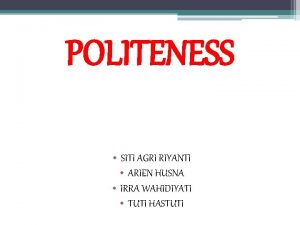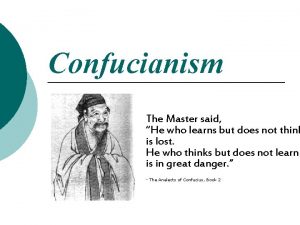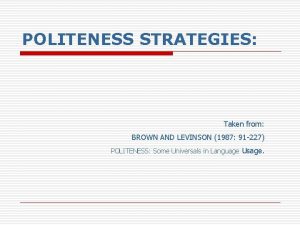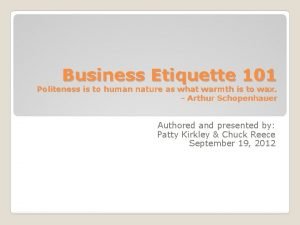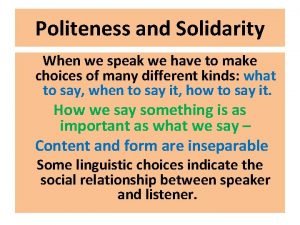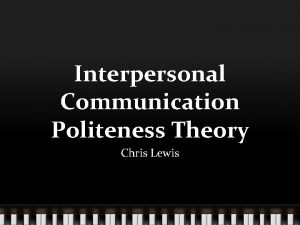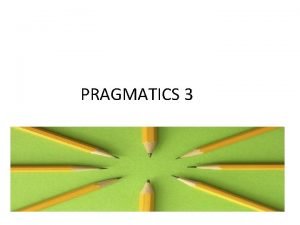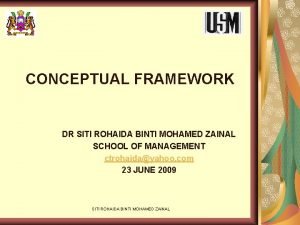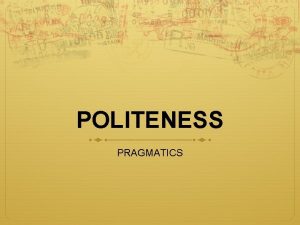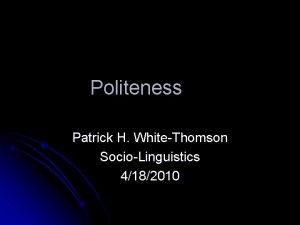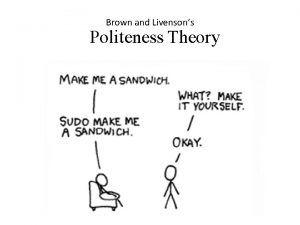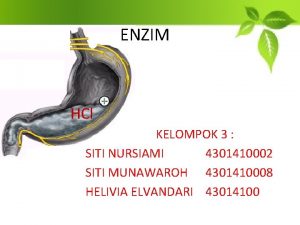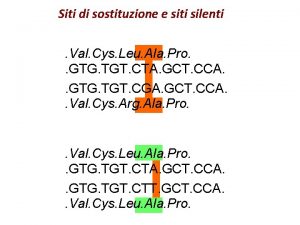POLITENESS SITI AGRI RIYANTI ARIEN HUSNA IRRA WAHIDIYATI










































- Slides: 42

POLITENESS • SITI AGRI RIYANTI • ARIEN HUSNA • IRRA WAHIDIYATI • TUTI HASTUTI

Theories of Politeness • • Introduction Delimiting the concept of politeness Politeness as a real-world goal Deference versus politeness Register Politeness as an utterance level phenomenon Politeness as an pragmatic phenomenon

Introduction Politeness is best expressed as the practical application of good manners or etiquette In the past twenty-five years within pragmatics there has been a great deal of interest in “politeness” to such an extent that politeness theory could almost be seen as a sub-discipline of pragmatics. Politeness can be defined as the means employed to show awareness of another person’s face. In this sense, politeness can be accomplished in situations of social distance or closeness. Showing awareness for another person’s face when that other seems socially distant is often described in terms of respect or difference.

Delimiting the concept of politeness • The vast literature on politeness which has built up since the late 1970 we find tremendous confusion. • The confusion begins with the very term politeness, which like cooperation has caused much misunderstanding. • The heading of politeness have five separate, though related, sets of phenomena as; politeness as a real-world goal, deference, register, politeness as a surface level phenomenon, politeness as an illocutionary phenomenon.

Politeness as a real-world goal • Politeness as a real-world goal defined politeness interpreted as a genuine desire to be pleasant to others, or as the underlying motivation for an individual’s linguistic behavior has no place within pragmatics. • In politeness as a real-world goal have no access to speaker’s real motivation for speaking as they do, and discussions as to whether one group of people is “politer” than another. • In politeness have access only to what the speakers say and to how their hearers react.

Deference versus politeness Deference • Deference is connected with politeness, but is a distinct phenomenon; it is a opposite of familiarity. Politeness • Politeness is a more general matter of showing (rather, of giving the appearance of showing) consideration to other.

• Both deference and politeness can be manifested through general social behavior as well as by linguistics means. Such as we can show deference by standing up when a person of superior status enters a room, or show politeness by holding a door open to allow someone else to pass through. • Deference and politeness are distinct, though related systems, by noting that it is possible to be deferential without being polite.

Register is primarily a sociolinguistic phenomenon: a description of the linguistic forms which generally occur in a particular situation. Choice of register has little to do with the strategic use of language and it only becomes of interest to the pragmatics if a speaker deliberately uses unexpected forms in order to change the situation or to challenge the status quo. Register has little to do with politeness and little connection with pragmatics, since we have no real choice about whether or not to use formal language in formal situations.

Politeness as an utterance level phenomenon • Politeness as an utterance level phenomenon defined his interest as being to investigate how much politeness could be squeezed out of speech act strategies alone and to investigate the perception of politeness by native and nonnative speakers. • In utterance level phenomenon , we find relates to the pragmatics and sociolinguistics such as listing the linguistics forms which can be used to perform a speech act in a given language is not pragmatics, any more than, say, listing all the words etc.

• In politeness as an utterance phenomenon find that one language has forms available for performing a particular speech act and that these correspond in another language. • In politeness as an utterance phenomenon find how a particular form in a particular language is used strategically in order to achieve the speaker’s goal, the perceived politeness of a speech act, and unsafe to equate surface linguistic form with politeness is that some

Politeness as a pragmatic phenomenon • Politeness as a pragmatic phenomenon defined has focused on writings politeness is interpreted as a strategy (series of a strategies) employed by a speaker to achieve a variety of goals. • These strategies may include the strategies use of the conventional politeness strategies but also include a range of other strategies, including many forms of conventional and nonconventional indirectness.

Politeness explained in terms of principles and maxims Before Leech, there are two main approaches to politeness. Firstly Lakoff sees Grice’s rules as essentially rules of clarity, and proposes that there are two prior rules of pragmatic competence: “Be Clear” and “Be Polite”. Here, clarity amounts to a condensed version of the Gricean maxims, while politeness serves to avoid conflicts between participants. She proposes her own three rules of politeness: formality: don’t impose/remain aloof; hesitancy: give the addressee his options; equality: act as though you and the addressee were equal/make him feel good Secondly, the face-saving view of politeness, proposed by Brown and Levinson (1978) is related to the folk expression “lose face”. They suggest two kinds of face.

• One is “positive face”, the positive consistent self-image that people have and want to be appreciated and approved of by at least some other people. • The other is “negative face” or the rights to territories, freedom of action and freedom from imposition; essentially the want that your actions be not impeded by others. • Negative politeness is found in ways of mitigating the imposition: ▫ Hedging: Er, could you, er, perhaps, close the, um , window? ▫ Pessimism: I don't suppose you could close the window, could you? ▫ Indicating deference: Excuse me, sir, would you mind if I asked you to close the window? ▫ Apologizing: I'm terribly sorry to put you out, but could you close the window? ▫ Impersonalizing: The management requires all windows to be closed.

• Brown and Levinson sum up human politeness behaviour in four strategies, which correspond to these examples: ▫ The bald on-record strategy: does nothing to minimize threats to the hearer's “face” ▫ Examples: An emergency: Help! Task oriented: Give me those! Request: Put your jacket away. Alerting: Turn your lights on! (while driving) ▫ The positive politeness strategy: shows you recognize that your hearer has a desire to be respected. It also confirms that the relationship is friendly and expresses group reciprocity. ▫ Examples: Attend to the hearer: You must be hungry, it's a long time since breakfast. How about some lunch? Avoid disagreement: A: What is she, small? B: Yes, yes, she's small, smallish, um, not really small but certainly not very big Assume agreement: So when are you coming to see us? Hedge opinion: You really should sort of try harder.

▫ The negative politeness strategy: also recognizes the hearer's face. But it also recognizes that you are in some way imposing on them. Some other examples would be to say, “I don't want to bother you but. . . ” or “I was wondering if. . . ” ▫ Example: Be indirect: I'm looking for a pen. Request forgiveness: You must forgive me but. . Minimize imposition: I just want to ask you if I could use your computer? Pluralize the person responsible: We forgot to tell you that you needed to by your plane ticket by yesterday. ▫ The off-record indirect strategies: take some of the pressure off of you. You are trying to avoid the direct Face Threatening Act of asking for a beer. Instead you would rather it be offered to you once your hearer sees that you want one. ▫ Examples: Give hints: It's a bit cold in here. Be vague: Perhaps someone should have been more responsible. Be sarcastic, or joking: Yeah, he's a real Einstein (rocket scientist, Stephen Hawking, genius and so on)!

Ambivalent and Politeness • Leech looks on politeness as the crucial in accounting for why people are so often indirect in conveying what they mean. He thus puts forward PP so as to rescue the CP in the sense that PP can satisfactorily explain exception to and apparent deviations from the CP. • By employing an utterance which is ambivalent (i. e. one which has more than one potential pragmatics force), it is possible to convey messages which the hearer is liable to find disagreeable without causing undue offence. • The pragmatic force will be ambivalent and it is left to the readers to decide (a) what the precise force of the message is and (b) whether or not it applies to them.

• Example: • If you want to enjoy the full flavour of your food and drink you will, naturally, not smoke during the meal. Moreover, if you did smoke you would also be impairing enjoyment of other guests. • At a very expensive gourmet restaurant, the management obviously though it inappropriate simply to put up ‘No Smoking’ sign. Instead, it is left to the guests to decide for themselves whether they are being asked or ordered not to smoke.

Pragmatic Principles • Leech introduces the Politeness Principle (PP): Minimize (all things being equal) the expression of impolite beliefs; Maximize (all things being equal) the expression of polite beliefs • Leech introduces a number of maxims which he claims stand in the same relationship to the PP as Grice’s maxims (the Cooperative Principle). • He argues that these maxims are necessary in order to explain the relationship between sense and force in human conversation.

The six maxims of the PP Maxim of tact • Minimize cost to other. • Maximize benefit to other. Maxim of generosity • Minimize benefit to self. • Maximize cost to self. Maxim of approbation • Minimize dispraise of other. • Maximize praise of other.

Maxim of modesty • Minimize praise of self. • Maximize dispraise of self. Maxim of agreement • Minimize disagreement between self and other. • Maximize agreement between self and other. Maxim of sympathy • Minimize antipathy between self and other • Maximize sympathy between self and other.

Maxim of tact • The tact maxim relates to the size of imposition (which can be reduced by using ‘minimizer’), offering optionality (to mitigate the effect of a request), and the cost/benefit scale. • Examples: • Could I interrupt you for a second? If I could just clarify this then. • Would it be possible for you to lend me your car? • Could you lend me your car? • Will you lend me your car? • Lend your car. • You must lend me your car!

Maxim of generosity • This maxim can be said as minimize the expression if cost to other and maximize the expression of benefit to other. • Examples: • You must have another sandwich. • Do you have another sandwich? • Please have another sandwich. • Would you like to have another sandwich? • Would it be possible for you to have another sandwich? • Would you mind having another sandwich?

Maxim of approbation • We prefer to praise others and if we cannot do so, to sidestep the issue, to give some sort of minimal response (Well …) or to remain silent. • Examples: • It is normal to say: I enjoyed your lecture, while if you did not enjoy it, you would either keep quite about it or convey the fact more indirectly. • You are the best cook in the world. • What a marvelous cook you are! • You are really a good cook. • You certainly know something about cooking.

Maxim of modesty • The modesty maxim may, for example, lead someone to reject a compliment which had been paid to them. • Examples: • A: What a bright boy you are! You always get full marks. • B: Thank you. I have very good teachers. • B 2:Thank you. The exam questions are not that hard. • B 3: Thank you, but I am not the only one in the class that gets full marks. • B 4: Yes, I am, ain’t I?

Maxim of agreement • People are much more direct in expressing their agreement, than disagreement. • Someone who holds a diametrically opposed view to the one usually expressed begin a counter-argument by saying “Yes, but …” • Example: • A: I don’t want my daughter to do CSE, I want her to do ‘O’ level. • B: Yes, but Mr. Sharma, I thought we resolved this on your last visit.

Maxim of sympathy • A:I lost my kitten last week and I still can not get over it. • B 1: It is the most unfortunate that you lost your pet. • B 2: I know what it is like. You have all my sympathy. • B 3: I am sorry to hear that. • B 4: So, we don’t annoyed by that nasty little animal any more.

The agreement maxim Minimize the expression of disagreement between self and other, Maximize the expression of agreement between self and other. Example 18 Mr. Sharma : ‘O’ level. ught Sharma, I Mrs. Green Mr. but yes, : visit. Example 19 Mr. Sharma : Nehemulla is ideally suited to the class she’s in and this class will do CSE in two year’s time. Mrs. Green : No, my dear, no, it’s wrong! Mrs. Green is deputy head teacher of a school (a British women), Mr. Sharma, the Indian-born father of one of the pupils attending her school. They are involved in a major disagreement concerning the courses Mr. Sharma’s daughter will take the following year. Although Mrs. Green disagrees strongly with Mr. Sharma, she nevertheless observes the ‘Agreement Maxim’ to high degree.

The Pollyanna Principle The use of ‘minimizers’ such as a bit (‘this essay’s a bit short’, when in fact it is too much too short), but this is a strategy which is already adequately dealt with under the heading of ‘reducing the size of imposition’. Example 20 The speaker had just ‘lost’ two hours’ work on the word-processor. ‘Ah well, I’ll probably write it better second time around. ’ Example 21 The two speakers were discussing the bad impression which visitors would gain because of the appalling weather on a university open day. A : They’re not exactly seeing the place at its beast! B : Well, at least it’s not snowing.

Politeness and the Management of Face According to Brown and Levinson (1987; 61) the term ‘face’ as the public self-image that every member wants to claim for himself, consisting in two related aspects; es, to Negative face claim basic The : personal preserves, rights to non distraction- i. e. to freedom of action and freedom from imposition. Positive face The positive : consistent self-image or ‘personality’ (crucially including the desire that this self-image be appreciated and approved of) claimed by interactants.

According to Goffman (1967; 5) defined face as; ……the positive social value a person effectively claims for himself by the line others assume he has taken during a particular contact. Face is a image of self delineated in terms of approved social attributes – albeit an image that others may share, as when a person makes a good showing for his profession or religion by making a good showing for himself.

Within politeness theory ‘Face’ is best understood as every individual’s feeling of self-worth or self-image; this image can be damaged, maintained or enhanced through interaction with others. Face has two aspects; his Positive face in reflected : liked, approved of, respected and appreciated by others. reflected Negative face : impeded or put upon, to have the freedom to act as one chooses.

Face Threatening Acts According to Brown and Levinson, certain illocutionary acts are liable to damage or threaten another person’s face; such acts are known as ‘face threatening acts’ (FTAs). An illocutionary act has the potential to; Damage the hearer’s positive face For example; by, insulting H or expressing disapproval of something which H holds dear. Damage the hearer’s negative face For example; an order, will impinge upon H’s freedom of action. Damage the speaker’s own positive face Speaker has to admit to having botched a job. Damage the speaker’s own negative face Speaker is concerned into making an offer of help.

In order to reduce the possibility of damage to H’s face or to the speaker’s own face, he/she may adopt certain strategies. The choice of strategy will be made on the basis of the speaker’s assessment of the size of the FTA. The speaker can calculate the size of the FTA on the basis of parameters of; Power (P) Distance (D) Rating of imposition (R)

Super strategies for performing face threatening acts Possible Strategies for doing FTAs Without redressive action, bald on record On record Positive politeness Do the FTA with redressive action Negative politeness Off record Strategies Don’t do the FTA

Performing an FTA without any redress (bald on record) The speaker is likely to focus on the propositional content of the message, and play little attention to the interpersonal aspect of what is said. Example 25 The speaker knows that a bomb has been planted in the stands at his racecourse. He thinks his young nephew is hiding in the stands. ……. Toby, get off the stands. The stands are not safe. Toby, for Christ’s sake does what I say. This is not a game. Come on, you little bugger……. for once in your life, be told.

Performing an FTA with redress (positive politeness) Within Brown and Levinson’s theory, when you speak to someone you may orient yourself towards that individual’s positive face, and employ positive politeness (which appeals to H’s desire to be liked and approved of). Brown and Levinson list fifteen positive politeness strategies, those are; 1. Notice, attend to H (his interest, wants, needs, goods) 2. Exaggerate (approval and sympathy with H) 3. Intensify interest to H 4. Use in group identity markers 5. Seek agreement 6. Avoid disagreement 7. Presuppose/raise/assert common ground 8. Joke 9. Assert or presuppose S’s knowledge of and concern for H’s wants 10. Offer, promise 11. Be optimistic 12. Include both S and H in the activity 13. Give (or ask for) reasons 14. Assume or assert reciprocity 15. Give gifts to H (good, sympathy, understanding, cooperation)

Example 30 Male first- year student calling to female first- year students (whom he didn’t know) in their college bar during ‘Fresher’s week’. Hey, Blondie, what are you studying, then? French and Italian? Join the club! The young man employed no fewer than three Brown and Levinson’s politeness strategies; 1. Use in group identity markers Blondie 2. Express interest in H asking her what she is studying 3. Claim common ground join the club!

Performing FTA with negative politeness -Negative politeness is oriented towards a hearer’s negative face -manifests irself in the use of conventional politeness markers, deference markers, minimizing imposition, etc

Some negative politeness strategies 1. 2. 3. 4. 5. 6. 7. Be conventionally indirect Hedge Minimize imposition Admit the impingiment and beg forgiveness Point of view distancing Go on record as incurring a debt State FTA as a general rule

Performing FTA using off record politeness 1. 2. 3. 4. 5. Give hints Use metaphor Be ambiguous or vague Be incomplete/use ellipsis etc

Do not perform FTA There are times when something is potentially so face threatening, that we dont say it. We use: 1. Saying nothing strategy 2. Opting out choice strategy

Politeness viewed as a conversational contract According to Fraser (1990), people are constrained in interaction called ‘conversational contract’ which people bring to an interaction of the norms obtaining within that interaction and of their rights and obligations within it
 Tact maxim examples
Tact maxim examples Iman husna rtm
Iman husna rtm Husna bedeutung
Husna bedeutung Peta konsep asmaul husna kelas 7
Peta konsep asmaul husna kelas 7 Al imanu billahi artinya
Al imanu billahi artinya Husna bedeutung
Husna bedeutung El ekrem
El ekrem Sasaran promosi kesehatan
Sasaran promosi kesehatan Pengertian asmaul husna secara istilah
Pengertian asmaul husna secara istilah Mustean
Mustean Meneladani asmaul husna al karim
Meneladani asmaul husna al karim Asmaul husna
Asmaul husna Bab 1 mengenal allah melalui asmaul husna
Bab 1 mengenal allah melalui asmaul husna Iman husna rtm
Iman husna rtm Where was confucius born
Where was confucius born Politeness principle
Politeness principle Yellow journalism
Yellow journalism Spanish politeness
Spanish politeness Politeness strategy
Politeness strategy Face theory goffman
Face theory goffman Stadoffish
Stadoffish Business etiquette 101: social skills for success indireme
Business etiquette 101: social skills for success indireme What is politeness
What is politeness Negative politeness examples
Negative politeness examples Intonation rising and falling
Intonation rising and falling Corrective facework
Corrective facework Conversation and preference structure
Conversation and preference structure Až chlapečku zavřeš víčka
Až chlapečku zavřeš víčka Konstituen ayat
Konstituen ayat Siti sarah
Siti sarah 1800 dam/jam berapa hm/menit
1800 dam/jam berapa hm/menit Siti rohaida
Siti rohaida Schéma bytové rozvodnice
Schéma bytové rozvodnice Siti chuzaemi
Siti chuzaemi Siti karimah
Siti karimah Ad rivum eundem lupus et agnus venerant
Ad rivum eundem lupus et agnus venerant Siapa siti fatimah
Siapa siti fatimah Ve čtvercové síti je umístěn rovnoběžník abcd
Ve čtvercové síti je umístěn rovnoběžník abcd Siti khotimah
Siti khotimah Newborn respiratory rate
Newborn respiratory rate Siti aisyah binti akiah
Siti aisyah binti akiah Nebezpečí sociálních sítí prezentace
Nebezpečí sociálních sítí prezentace Syair siti sianah
Syair siti sianah
